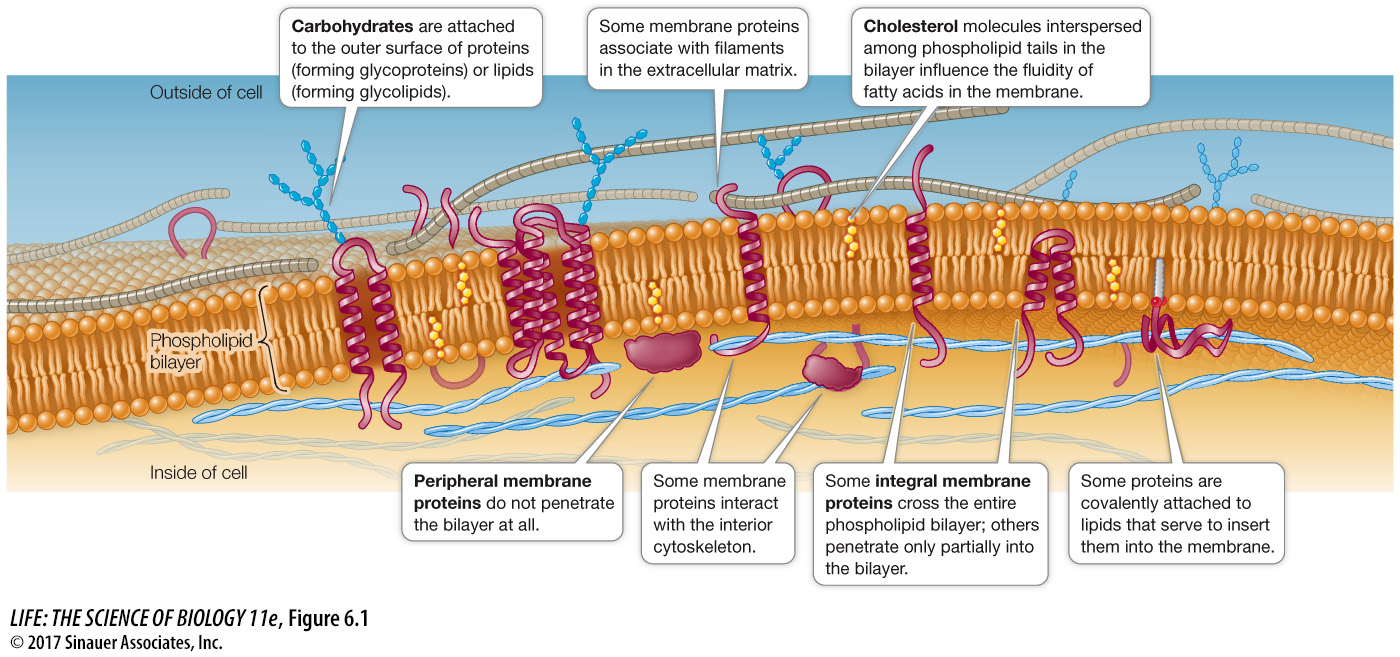key concept6.1Biological Membranes Are Lipid–
111
The physical organization and functioning of all biological membranes depend on their constituents: lipids, proteins, and carbohydrates. You are already familiar with these molecules from Chapter 3 and with membranes that enclose cells and organelles from Chapter 5. Lipids establish the physical integrity of the membrane and create a barrier to the rapid passage of hydrophilic materials such as water and ions. In addition, the phospholipid bilayer serves as a lipid “lake” in which a variety of proteins “float” (Focus: Key Figure 6.1). This general design is known as the fluid mosaic model. It is mosaic because it is made up of many discrete components, and fluid because the components can move freely.
focus: key figure

Activity 6.1 The Fluid Mosaic Model
www.life11e.com/
Question
Q: What kinds of chemical interactions hold some membrane proteins embedded in the membrane and others on the membrane surface?
Hydrophobic interactions keep some proteins embedded whereas ionic attractions keep others on the surface.
focus your learning
A lipid bilayer forms as the result of two kinds of inter-
actions: hydrophobic interactions between nonpolar tails of phospholipids, and hydrophilic interactions between polar heads of phospholipids and water molecules. Proteins associated with membranes may be embedded in the lipid bilayer or associated with exposed parts of the membrane.
Membranes are dynamic structures that undergo constant change.
The degree of a membrane’s fluidity is influenced by lipid composition and temperature.
The fluid mosaic model depicts proteins as noncovalently embedded in the phospholipid bilayer by their hydrophobic regions (or domains) or tethered to lipids inserted into the membrane. Proteins may span the membrane or may be bound on the surface. Their hydrophilic regions are exposed to the watery conditions on either side of the bilayer. Membrane proteins have several functions, including moving materials through the membrane and receiving chemical signals from the cell’s external environment. Each membrane has a set of proteins suitable for the specialized functions of the cell or organelle it surrounds.
The carbohydrates associated with membranes are attached either to the lipids or to protein molecules. In cell membranes, carbohydrates are located on the outside of the cell, where they may interact with substances in the external environment. Like some of the membrane proteins, carbohydrates are crucial in recognizing specific molecules, such as those on the surfaces of adjacent cells.
Although the fluid mosaic model is largely valid for membrane structure, it does not say much about membrane composition. As you read about the various molecules in membranes in the next sections, keep in mind that some membranes have more protein than lipids, others are lipid-